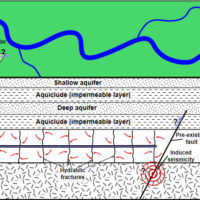Revisiting the Chesapeake Bay
The Effect of Population Growth on America’s Largest Estuary
- Tom Horton
- March 28, 2013
- Forum Papers
- Forum Paper
- 0 Comments
Click here for a downloadable, printable PDF version
The once-acclaimed program to restore the Chesapeake Bay has fallen short of every hopeful ambition. For three decades the Bay’s fundamental declines have barely budged, despite billions of dollars spent on cleanup efforts by the federal government and six states that share the 64,000-square-mile Chesapeake watershed. And many experts feel that if the watershed area population continues to grow, cleanup effort will keep coming up short.
The greater Chesapeake Bay area population doubled in the last 50 years, a major reason the estuary still struggles after nearly 30 years of a combined federal and state restoration. But the Bay is just a small window to what has become a world-wide crisis. Globally, with population now over 7 billion, an estimated 60% of natural systems are in decline, from rainforests to ocean fisheries.
In this Forum paper, using research from Chesapeake Bay expert Tom Horton, NPG examines the current environmental state of the watershed area. The continued deterioration of the Bay ecosystem is a cautionary tale – this kind of environmental devastation, directly linked to population growth, is irrefutable evidence of what we can expect for the rest of America and the world. As U.S. population numbers continue to climb, we inflict the same pollution, overdevelopment, and loss of habitat from coast to coast.
When the U.S. Environmental Protection Agency (EPA) conceded in 2007 that Bay cleanup would fall far short of a 2010 deadline, a one-word response said it all. “Duh,” Roy Hoagland, a vice president of the Chesapeake Bay Foundation (CBF), told The Washington Post.
Since 1998, the CBF has kept its own report card on Bay health, based on 13 indicators of water quality, habitat and marine life. Its goal was a score of 40 by 2010, on a scale of 0 to 100. This would return the Bay to the considerable health it enjoyed 40 or 50 years ago. In 2013, the CBF raised the Bay rating for the first time in years to just 32, which they equate to a D+ grade.
Analysis performed river-by-river around the Chesapeake by University of Maryland scientists in 2011 gave similar scores, in the C- to D range. The EPA, which oversees the restoration, expressed Bay health in 2008:
- Water quality: 29% of goals met; habitat: 35% of goals met; chemical contaminants: 47% of goals met.
- Blue crabs, the Bay’s last great commercial fishery, are at historic lows, with both Maryland and Virginia sharply restricting the catches of beleaguered watermen.
- Oyster harvests once accounted for a fifth of everyone fishing for a living in America, but they are virtually gone except as a farmed crop supported by hatcheries on land. Shad, once harvested in the millions of pounds, are at 3% of restoration goals.
- Nitrogen, the Bay’s principal pollutant, is close to twice what a healthy Bay could stand, with only slight overall reduction in Bay waters since the 1980s, and rising levels in some rivers. Nitrogen comes from farms, development, auto and power plant emissions, and sewage-treatment plants and septic tanks. A potent fertilizer, it fuels explosive growth of algae when too much enters waterways. The algae can be toxic and absorb oxygen needed by marine life; it also makes the water murky, shading out light needed by seagrasses vital to fish and crabs. The same problems, all related to human population growth, now plague coastal waters around the globe.
Tom Horton covered environmental issues for The Baltimore Sun from 1974 – 2006 and was an educator at the Chesapeake Bay Foundation for five years. He is author of several books about Chesapeake Bay and has written for National Geographic, The New York Times and The Boston Globe. He teaches writing and environmental studies at Salisbury University, and contributes regularly to Chesapeake Bay Magazine and the
Bay Journal News Service . He currently lives in Salisbury, MD, where he is a professor of Environmental Studies at Salisbury University and a contributor to the Bay Journal.

